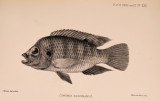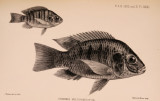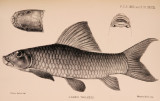| OCR Text |
Show 1902.] I'LECTOGXATIIOUS FISHES. 293 Xenopterus and Chonerhinus, on the contrary, it has become excessively developed. Dr. Gill (Proc. U.S. 1ST. M. xiv. pp. 705-720, pi. xxxiv. (1890)) ha s arranged the fishes which I here include in the family Tetro-dontidse in three families: Tetrodontidse, Chonerhinidse, and Canthigasteridse, which are chiefly distinguished by supposed cranial differences. In the Canthigasteridse and Chonerhinidse the post-frontals are said to meet in the middle line, thus separating the frontals from the supraoccipital. An examination of the skeletons has convinced me that in these fishes the post-frontals are confined to the sides, and that the frontals are in contact with the supraoccipital. The erroneous statements and figures of Hollard have met with too ready an acceptance, that author having mistaken ridges on and fissures in the frontal bones for sutures between them and the post-frontals. The Canthigasteridae are also defined as having a long prominent A Text-fig. 58. B A. Skull of Tetrodon sceleratus, seen from above (on the right the posterolateral process of the frontal has been removed). B. Skull of TropidichtJiys papua, seen from above. C. „ „ » side view-pm., premaxillarv ; m., maxillary ; pal., palatine ; eth., ethmoid ; prf., prsefrontal ; f , frontal"; ptf., postfrontal; sq., squamosal; par., parietal; co., exoccipital; so., supraoccipital. |
































































































































































































































































































































